You can make deliciously crusty, light, and flavorful sourdough French bread with your discard and a few simple ingredients – it’s an easy dough to make and rests overnight to get just the right rise with no yeast needed. Then, just shape, score, and bake to perfection. You’ll love how easy tried-and-true French bread with sourdough starter recipe is!
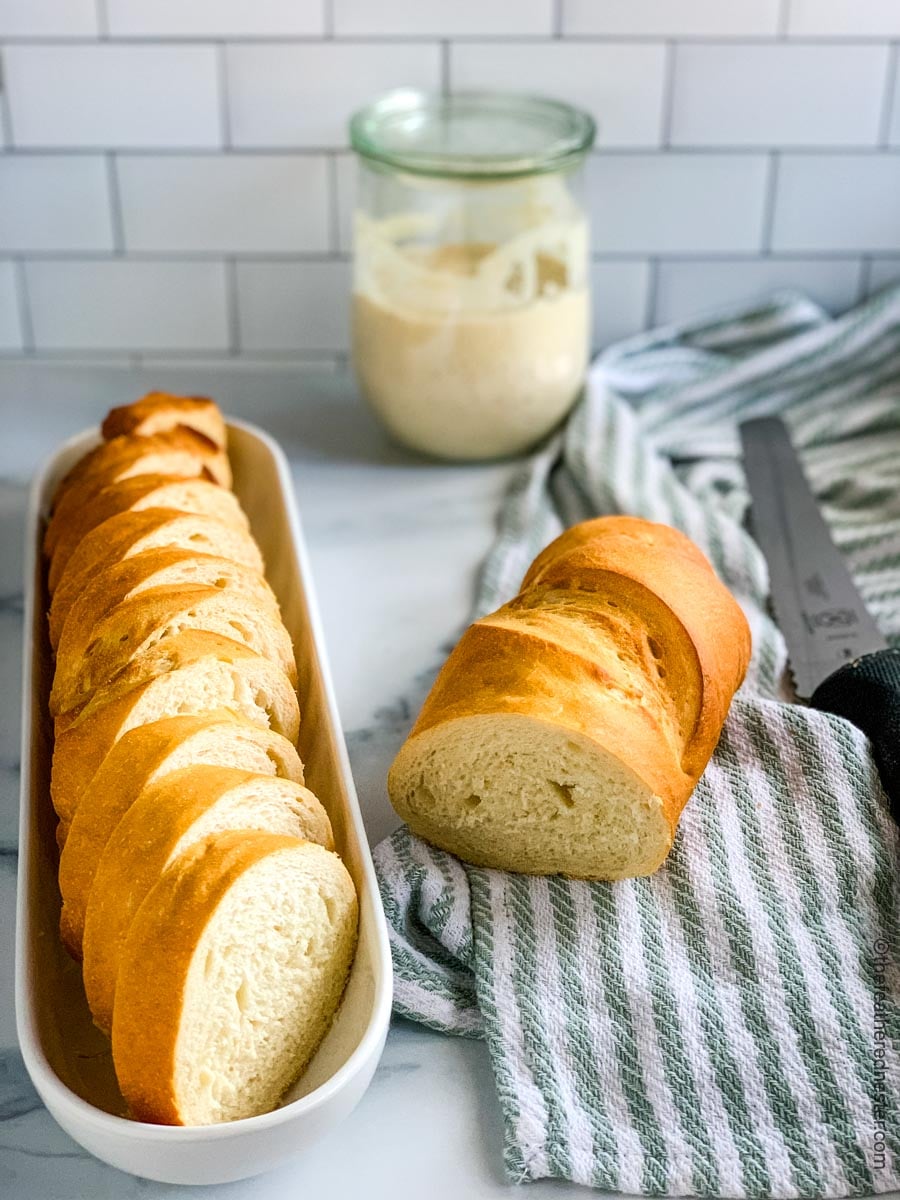
I’ve been into sourdough for years. Making no knead sourdough bread or soft sandwich bread with sourdough is so easy! And, we love the slightly tangy taste and great texture you get with our easy sourdough recipes.
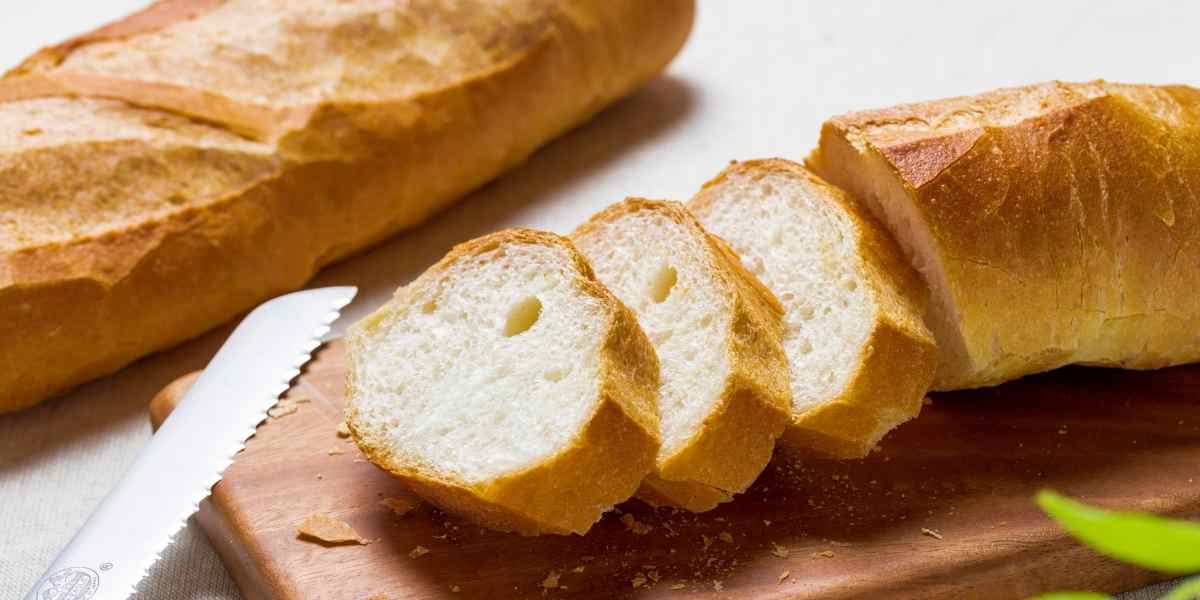
Our slew of sourdough pizza crusts are designed to help use up that discard (instead of throwing it away!) by making recipes like this French bread! It easily makes a flavorful baguette that is crusty on the outside and terrifically tender and fluffy on the inside.
Anyone who has tried making bread with sourdough discard knows that you need these 2 key things for the perfect loaf: A healthy starter (we recommend our quick guide to feeding sourdough starter) and a little patience. Plus we love this with fall soup recipes!
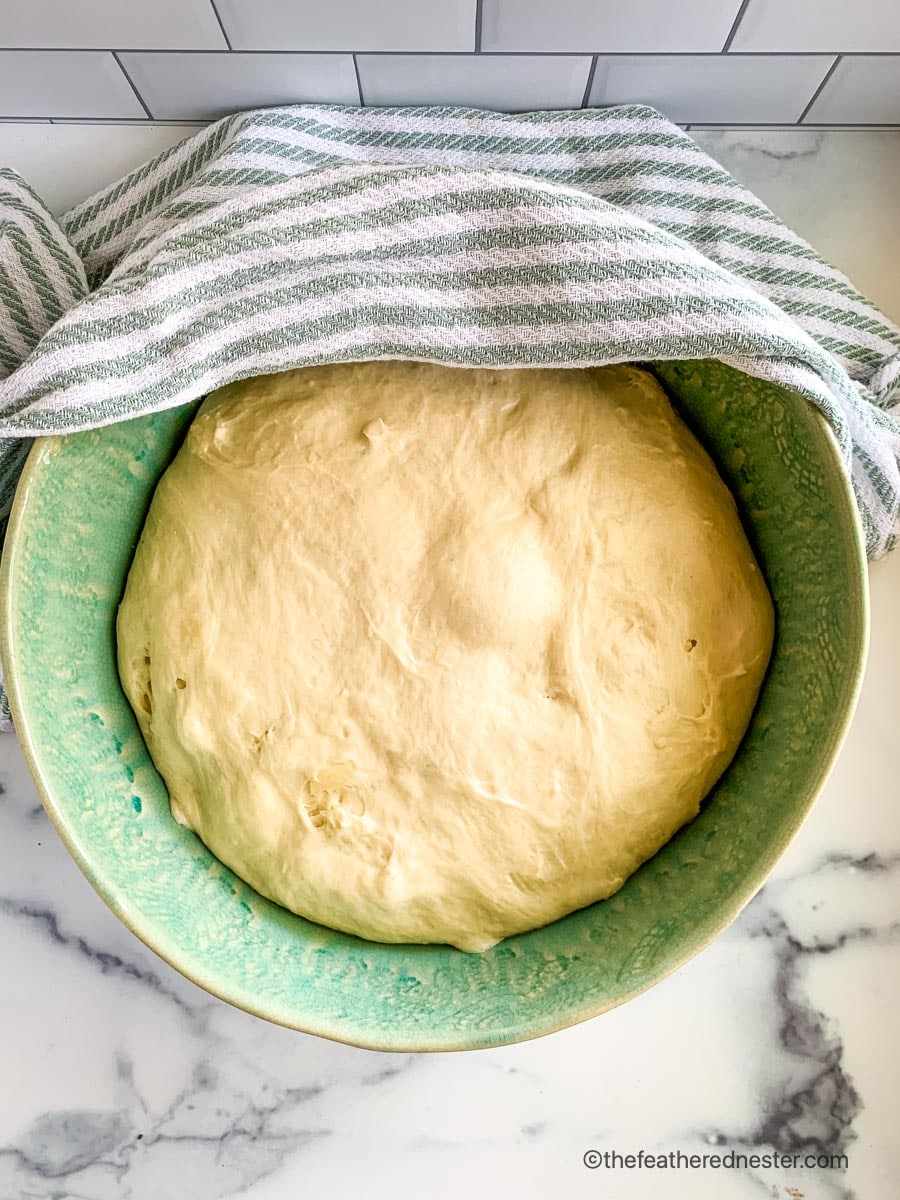
Content Covered Here
Sourdough French Bread Video Tutorial
Why We Love This Recipe
- You don’t need commercial yeast! With just your sourdough starter along with flour, water, oil, and a little sugar and salt, you’ll have the perfect hot loaf for your next meal just like our cinnamon raisin sourdough!
- It’s light and airy with that tangy sour taste that we all love! In fact, you’ll be amazed at how quickly this loaf of bread disappears.
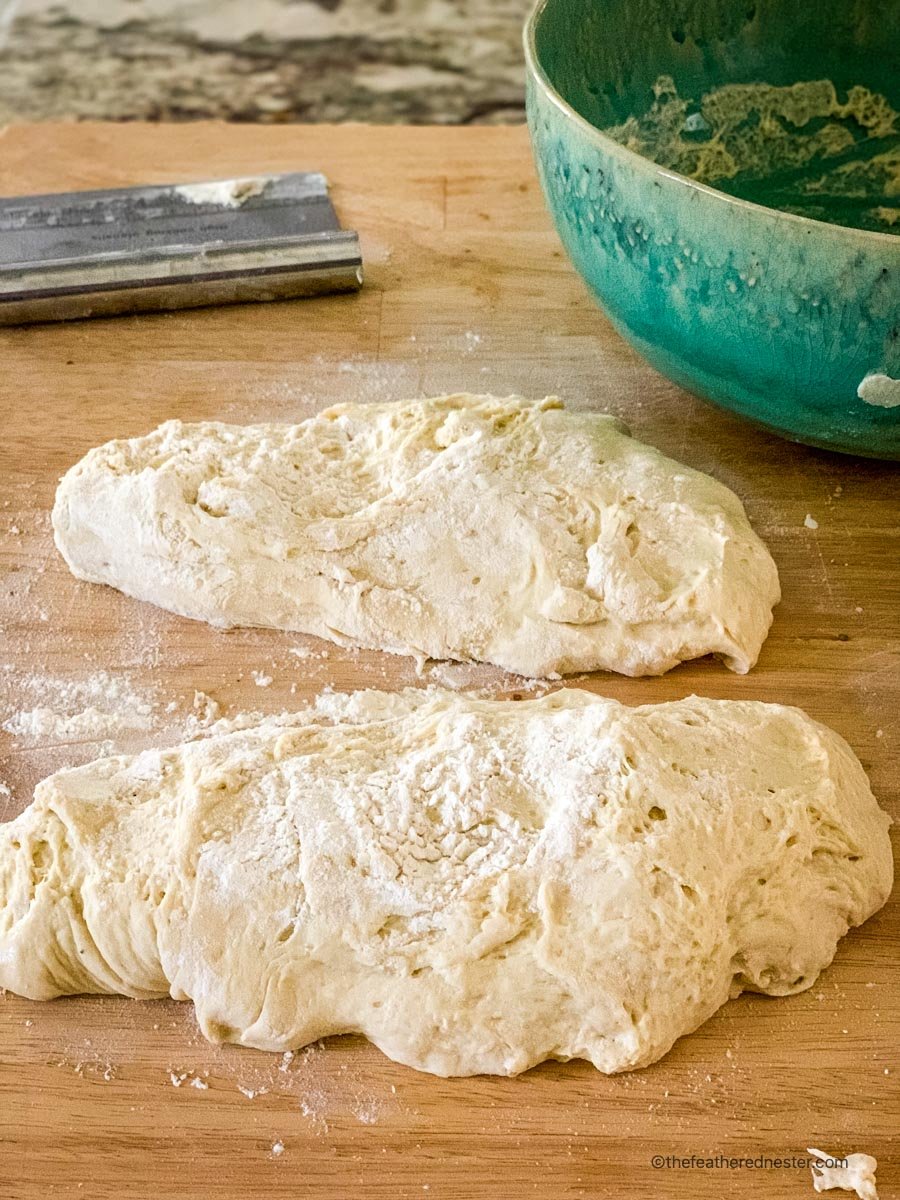
Ingredient Notes and Substitutions
- Active sourdough starter: fed 12-24 hours before starting the recipe.
When we say active, we mean a mature starter that is at least a week old and always doubles in size within 4-6 hours of feeding. It doesn’t mean you need to use it at the peak activity after a feeding. - Sugar: helps activate the sourdough sponge. The small amount of sugar won’t give this bread a sweet taste. You can substitute sugar for 25 grams or 3 1/2 teaspoons of honey.
- Olive oil or vegetable oil: adds a lighter consistency to the dough.
- All-purpose flour: look for unbleached or organic all-purpose flour. I prefer to use King Arthur all-purpose flour. You can substitute all-purpose flour for an equal amount of bread flour.
- Salt: I typically use sea salt. If you use Kosher salt, increase it to 3 teaspoons or 22 grams.
🎯 TFN Pro Tip
This is a discard recipe, but your discard should come from an active starter fed within the last day (if stored on the counter) or the last week (if stored in the refrigerator). I feed mine within 12 to 24 hours before starting any bread recipes.
How to Make French Sourdough Bread
We’re presuming that you already have an active sourdough starter on hand. Feed your starter 12-24 hours before starting the dough.
Although it does take some time to prepare, there are only 5 simple steps to make a perfect French bread with no yeast:
- Mix the dough either by hand or with a standing mixer.
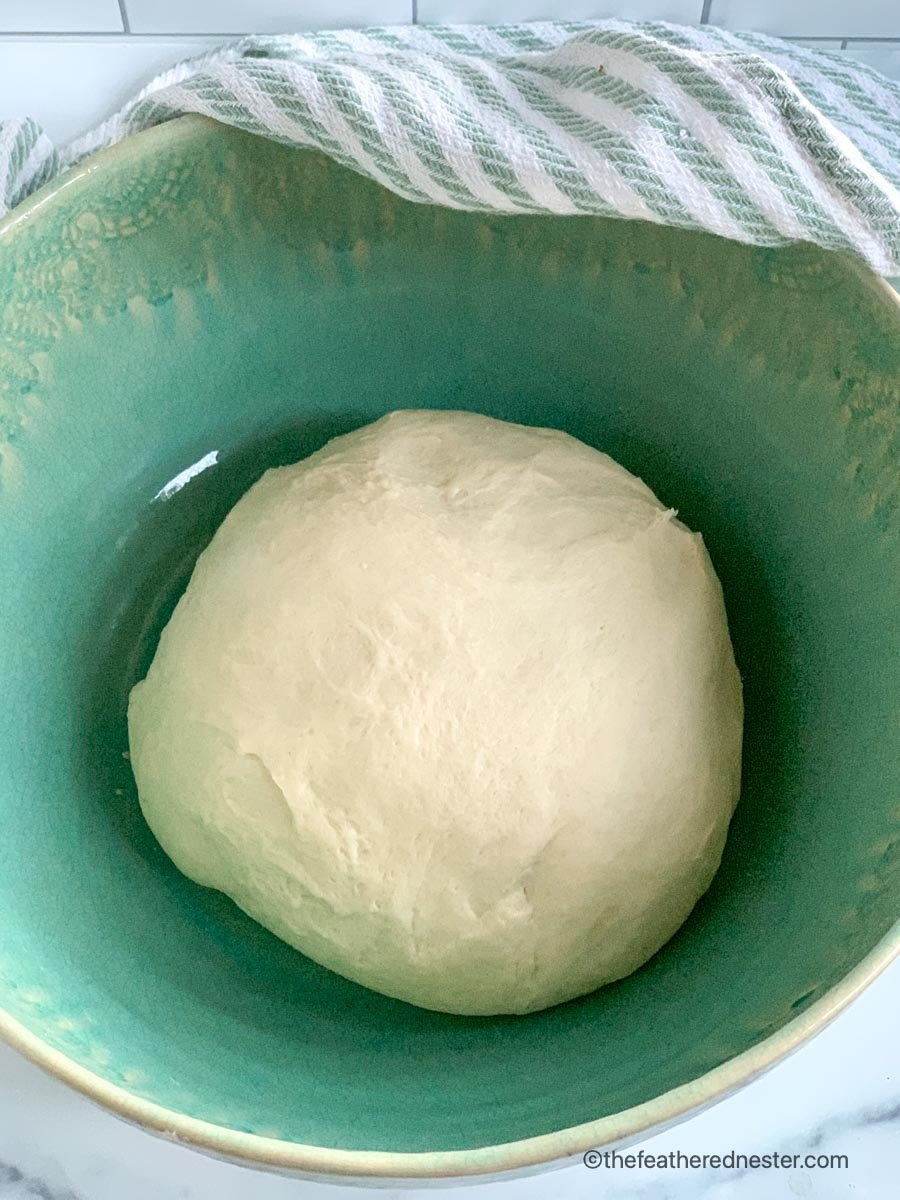
- Cover the dough and let it rise (ferment) overnight.
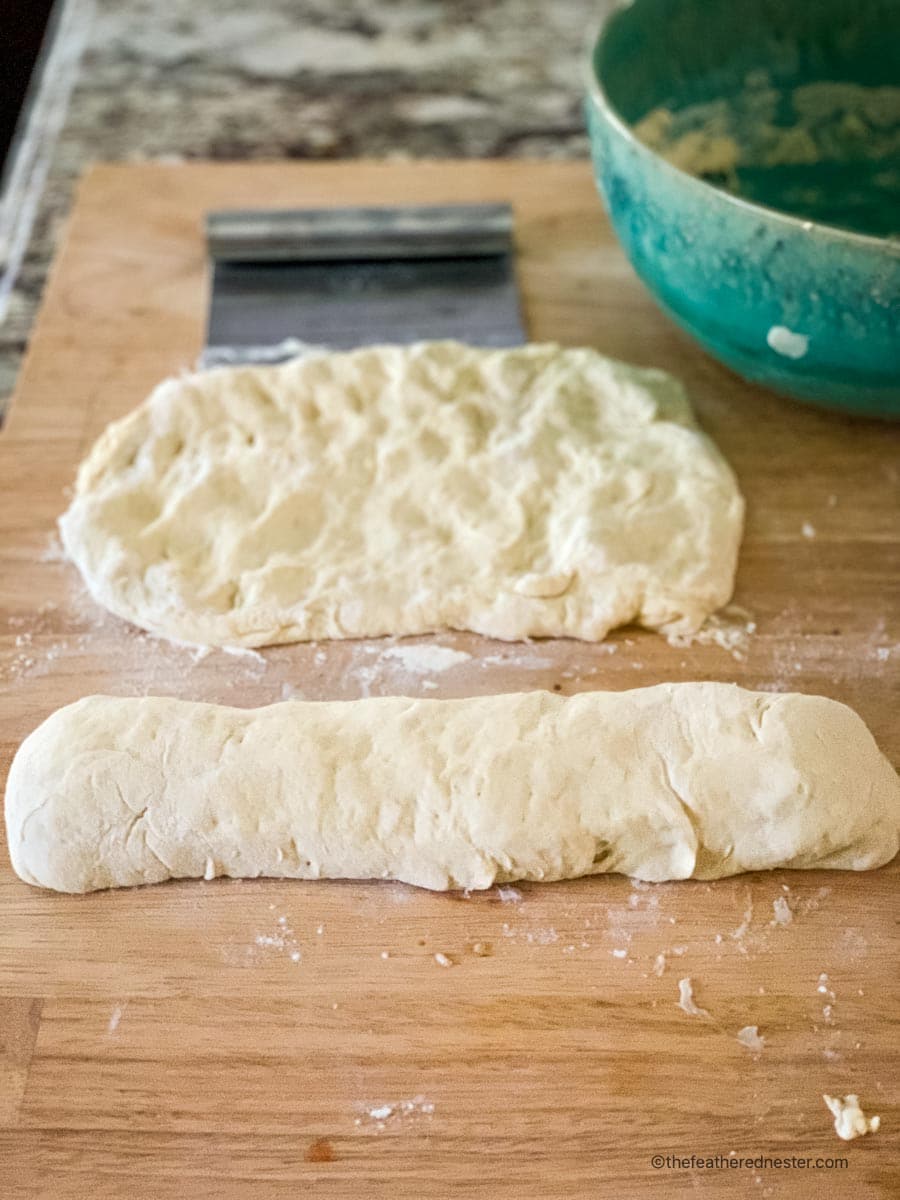
- Shape the dough, cover it with plastic wrap on a baking sheet, and let rise one more time.
- Score the loaves with a sharp knife.
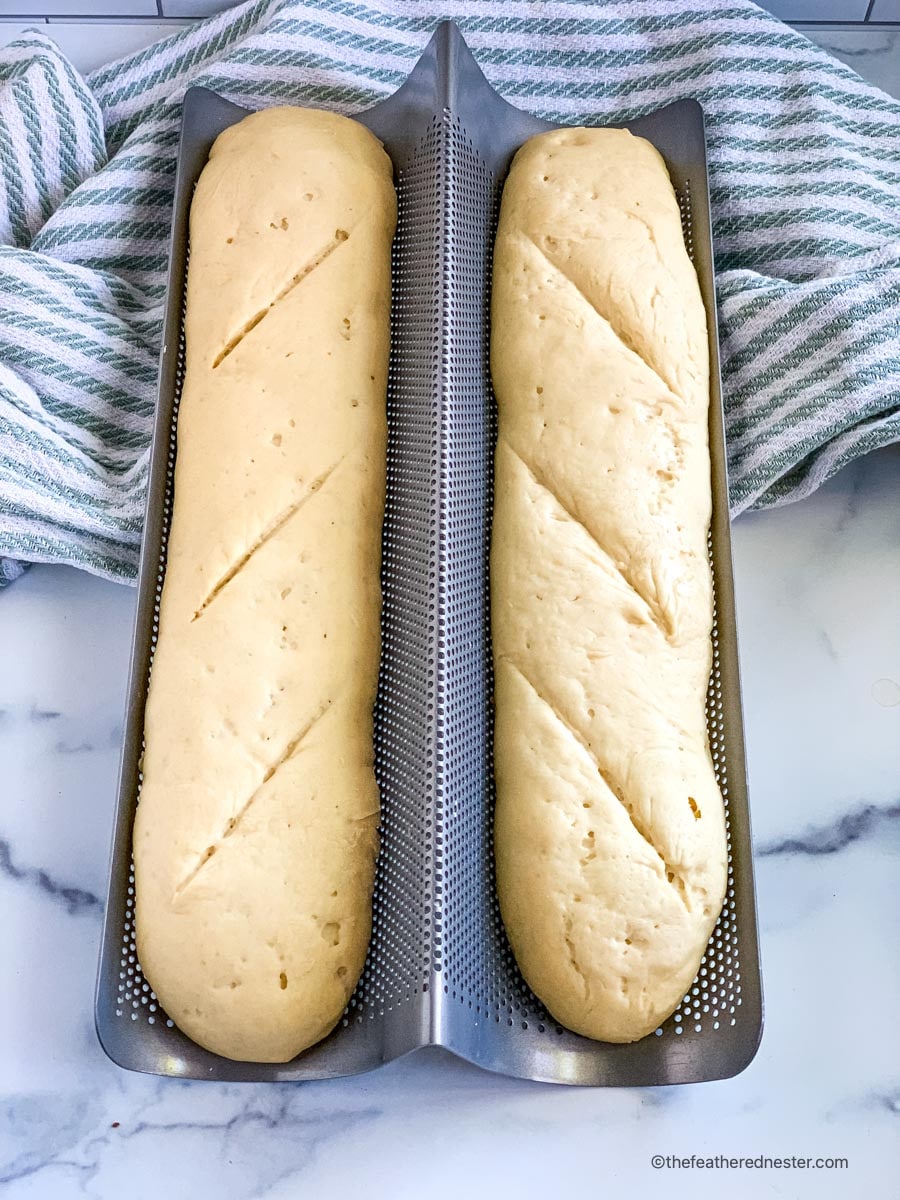
- Bake for 25-30 minutes in a preheated oven to 400 degrees F.
- Let it cool for about 15 minutes before serving it warm with salted butter or herb garlic butter for a tasty loaf of garlic bread with dinner.
Keep reading for our foolproof tips!
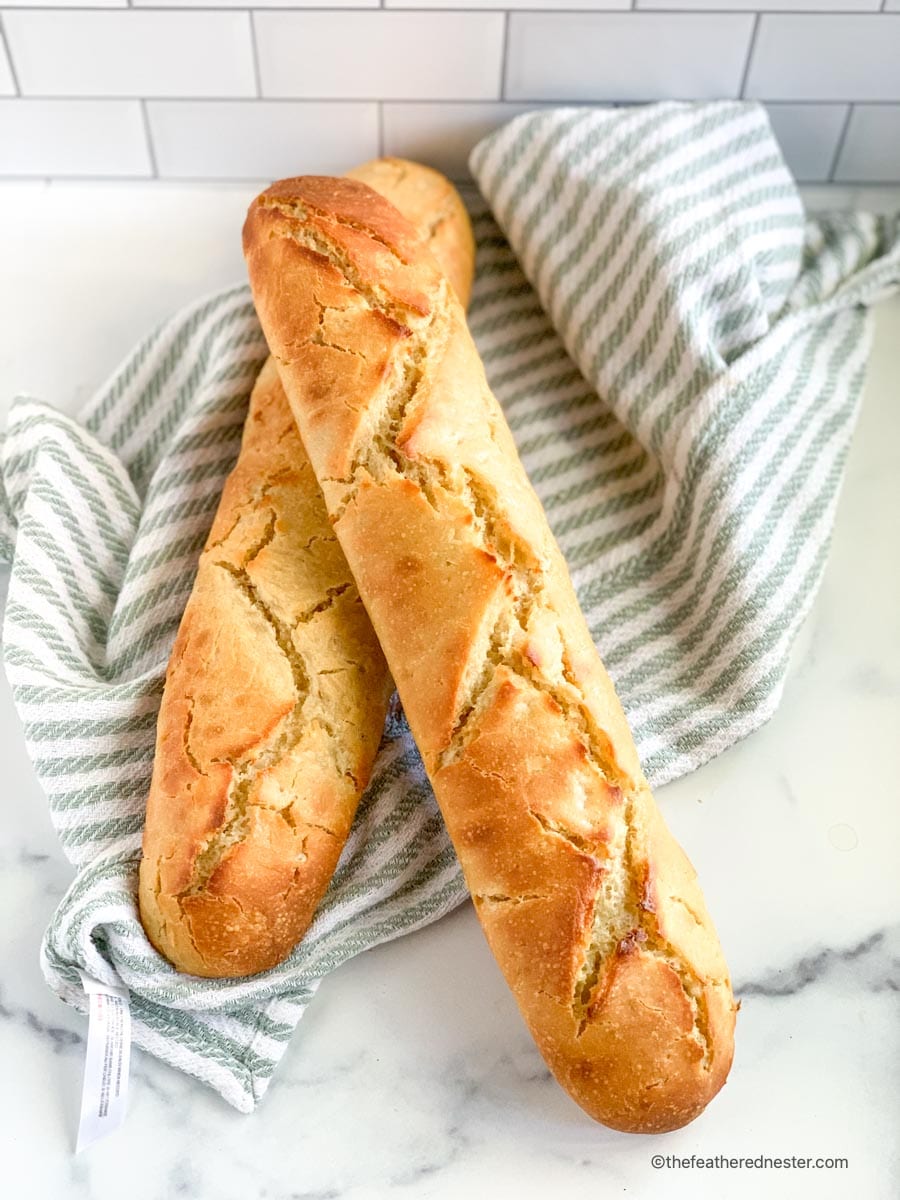
Because there is no yeast used, this recipe needs kneading to get that classic French bread texture. For no-knead sourdough recipes, see my overnight sourdough bread or sourdough sandwich bread recipes.
My favorite way to knead any bread dough is with my stand mixer.
However, if you don’t have a stand mixer, you can knead the dough by hand. Use a timer to keep track of how long you knead the bread. If your arms get tired, take a break for a moment or two and resume.
A video showing how to knead
The dough above is soft and stretchy. When stretched, it was thin enough to see through without holes. This is called the window pane test.
Tips for Proper Proofing of French Bread
The sourdough undergoes a fermentation process during the overnight proofing. Here are a few signs that your dough has finished proofing (and is fermented):
- It has doubled in size. In cooler temperatures (less than 75º) this may take longer.
- You can see bubbles in the dough. There are finger-tip-sized bubbles on the top and sides of the dough and smaller bubbles underneath.
- Sourdough fermentation takes hours, and your dough will need at least 6 hours and possibly 12 hours until the dough has proofed. Keeping the dough between 75º and 85ºF will speed up the fermentation process.
Signs your sourdough has finished proofing
- The dough should be smooth and pliable.
- It should stretch easily for several inches without holes or tears when stretched.
If not, the dough needs further kneading to make it as soft and pliable as it should be.
After a minute of hand kneading, it should look like this:
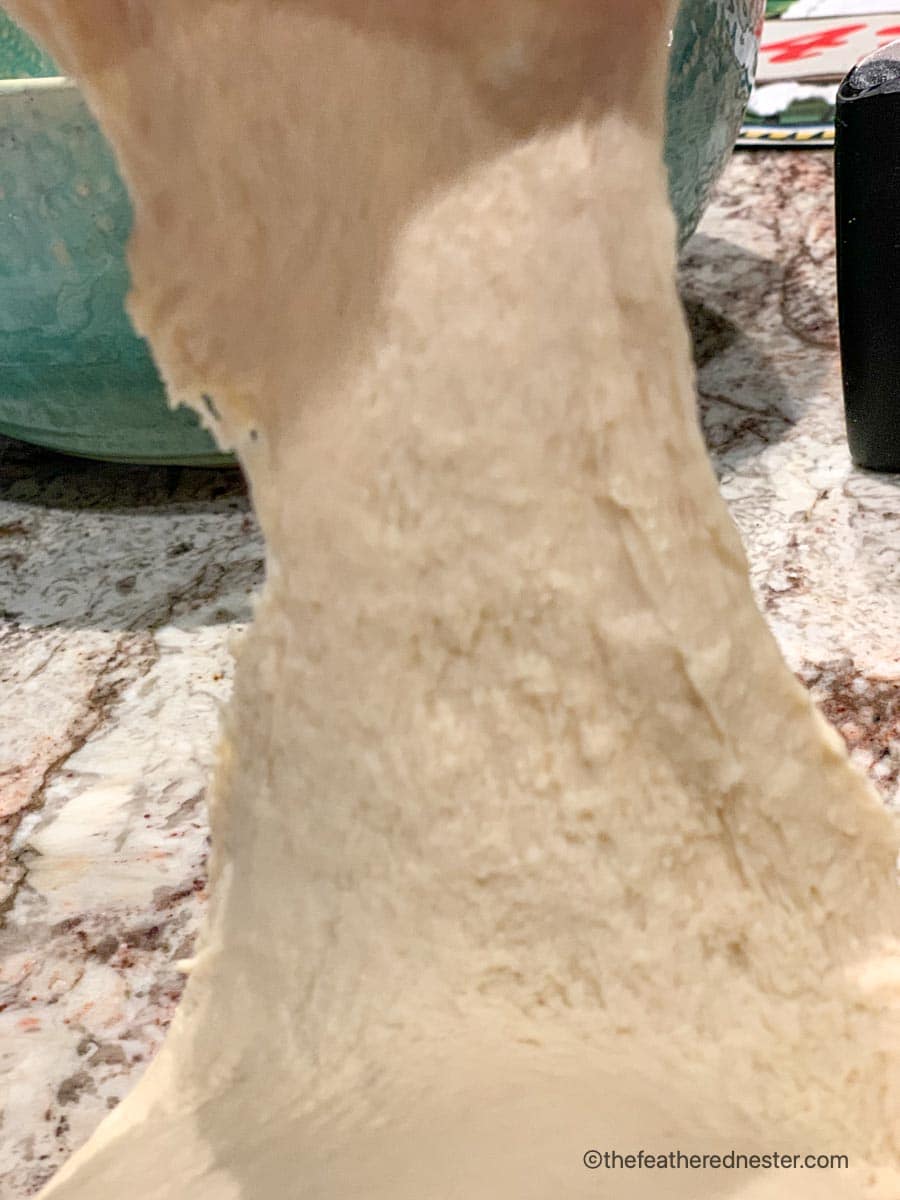
Underproofed dough is stiff and the surface of the dough is smooth.
Properly proofed dough shows bubbles on or below the surface. It’s soft, and the impression stays when you press your finger into it.
Over-proofed dough may spill over the sides of the bowl during proofing. To avoid over-proofed dough, set a timer per the recipe card and keep the dough at 85ºF or lower.
🎯 TFN Pro Tip
For a clean score, use quick, even motions. Sourdough scoring is only about 1/4″ to 1/2″ in depth. Side slashes work best for scoring loaves of French bread.
The scoring of the top is simple but necessary to keep it from cracking. Use a very sharp knife or lamé for sourdough scoring. I prefer to use a lamé or a serrated knife.
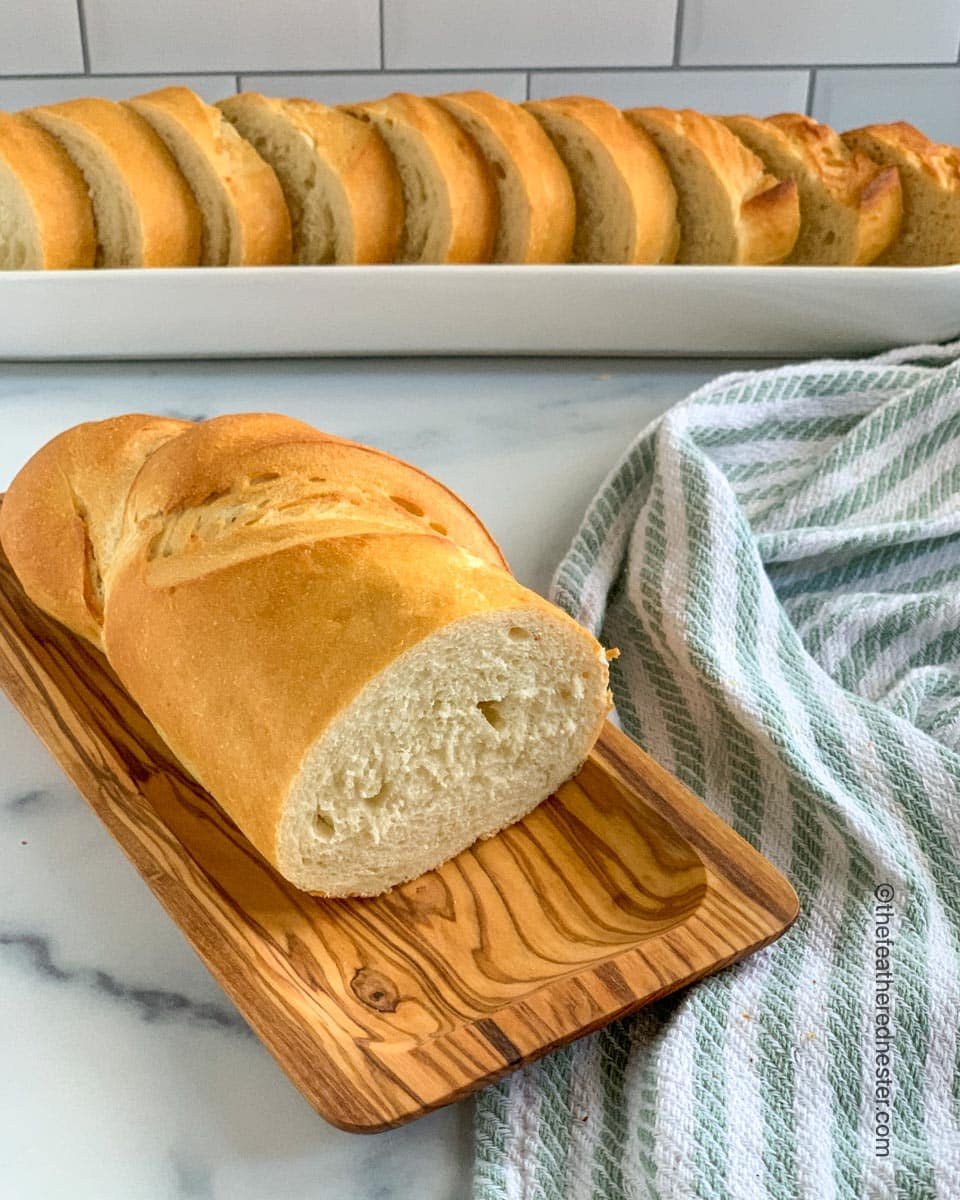
Recipe FAQs
When it’s ready to bake the dough should be doubled in size with visible bubbles in the dough. See above under “signs your sourdough has finished proofing” where I explain this a bit more.
Yes! It has a bit more protein in it, which will add more gluten to the recipe, but is a suitable substitute for all-purpose flour.
Weighing your baking ingredients is more reliable for baking. For those of you without kitchen scales, I’ve listed the cup measurements in the full recipe card below.
When my sourdough bread is past its prime, I slice it into cubes and dry or toast it to make stuffing with sourdough bread or slice it for French toast sourdough bread.
Your dough could dry out during the fermentation overnight, especially in areas with low humidity. The top layer of the dough will get a hard crust that prevents the dough from rising. So if you live in an area with lower humidity, I recommend covering the bowl with plastic wrap or a clean, damp kitchen towel.
More Easy Bread Recipes To Love…
- Double Chocolate Sourdough Bread
- Sourdough Bread Bowls Recipe
- Whole Wheat Sandwich Bread
- Monkey Bread Pizza
If you tried this sourdough French bread recipe or any other recipe on my website, please leave a 🌟 star rating and let me know how it went in the 📝 comments below. Thanks for visiting!
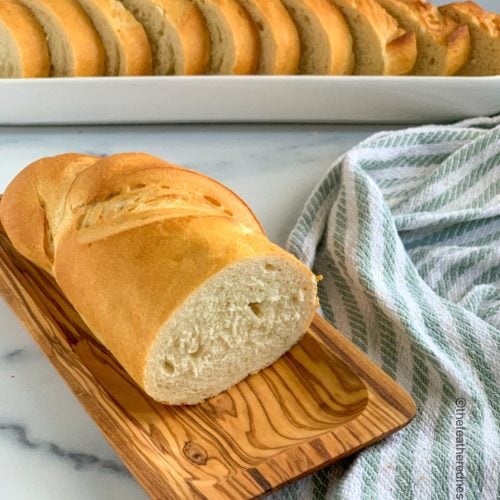
Sourdough French Bread
Equipment
- lamé - or sharp serrated knife
- French bread pans - or baking sheets
Ingredients
- 1 cup sourdough starter (250 grams) discard or fed 12-24 hours prior *see notes below
- 1 ½ cups warm water (350 grams)
- 2 tablespoons sugar (25 grams) see recipe notes below for using honey
- ⅓ cup extra virgin olive oil (70 grams) or your preferred cooking oil
- 4 cups all-purpose flour (500 grams) or bread flour, divided
- 2 teaspoons fine salt (10 grams)
Instructions
Mixing the sourdough bread sponge
- Combine starter, water, sugar, oil, and 3 cups (350 grams) flour in a medium bowl or the bowl of your stand mixer. Stir using a dough whisk or flat beater until a thick, sticky dough forms. This is called a sponge. Cover and let rest for 30 mins.
- Add salt to the dough, and slowly add the last 1 cup of flour, 1/2 cup at a time, until the dough pulls away from the sides of the bowl.
Kneading by hand
- Add 1 cup of flour (150 grams) on the countertop and knead in one cup of flour at a time until the dough is no longer sticky. Then knead for 10 minutes by hand until the dough is soft, smooth, and elastic. See video below for more tips. You should be able to stretch the dough for 4-5" without it tearing. Use a timer to time kneading and take short breaks if your arms get sore.
Stand mixer kneading
- Use the dough hook at low speed to mix the dough until it cleans the sides and bottom of the mixing bowl. Knead in mixer for 5-7 minutes, until a soft, smooth, and elastic dough forms. You should be able to stretch the dough for 4-5" without it tearing.
Overnight bulk fermentation rise
- Place dough into a large greased bowl turning the dough over, and cover with a clean damp towel or plastic wrap. Let rise at room temperature or a warm area 4-12 hours (see chart in notes below) to ferment.
Preparing the loaves
- Cut the dough in half. Flatten each half to a 5" x 7" rectangle (i use my fingertips to gently deflate or degas the dough). Then tightly roll on the long side. Pinch the ends to seal them.
- Place dough on lightly greased french bread pans, or place length-wise on a large parchment lined baking sheet. Cover with greased plastic wrap and let rise for 1 1/2 – 2 hours, until the loaves have increased in size and look puffy.
- Preheat oven to 400ºF (205º celcius). Using a very sharp knife or lamé quickly score loaves with 3 – 4 diagonal slashes. Make scores about 1/4" to 1/2" deep.
- Bake for 25 – 30 minutes. The loaves should be golden on the outside and sound hollow when tapped.
Video

Notes
- 80ºF about 4-5 hours
- 75ºF about 6-7 hours
- 70ºF about 8-9 hours
- For temperatures under 70ºF it can take up to 12 hours or more
- Place the bowl in the oven with the door closed and light on to create a slightly warmer climate without actually turning the oven on.
- Use a heated mat (like those used for germinating seeds) for rising.
- Use the “proof” setting of your oven (I set mine to 85ºF) and set a timer. This will speed up the rising process, so check it at 4 and 6 hours.
- If there is a sunny room in the house that stays warm, keep the dough covered in that area.
- For a clean score, use quick, even motions. I prefer to use a lamé or a serrated knife. Sourdough scoring is only about 1/4″ to 1/2″ in depth. Side slashes work best for scoring loaves of French bread.
- Scoring of the top is simple but necessary to keep it from cracking.
- Check to see if the top of the loaf is golden and if it sounds hollow when tapped on.
- Check the internal temperature in the center of the bread. It should 195º – 200ºF when done.
- Let the bread cool completely. Store it in a plastic bag at room temperature. I use a plastic bread bag with a twist tie to seal it and it stays fresh for about 5 days.
- This French bread is also great to freeze. Place in an airtight bag and store in the freezer for up to 3 months. Thaw loaves at room temperature, then slice and enjoy.
- Check out our in-depth guide on how to store fresh sourdough bread for more storage tips.


David Hendrix says
I can’t wait to try this.
Recipe it sounds great.
Danielle Green says
I have completed the bulk rise I don’t have time to bake today something came up. Can I shape this and put it in the fridge till I’m ready to bake?
Gianne - TFN Team Member says
Absolutely! While we haven’t personally tested refrigerating the shaped dough for this sourdough French bread recipe, we’ve heard from many readers who’ve done it with great success. After your bulk rise, you can go ahead and shape the dough, place it in your parchment-lined baking vessel or on a tray, cover it well, and pop it in the fridge. When you’re ready to bake, let it rest at room temperature while the oven preheats—just keep an eye on it to make sure it doesn’t overproof. It might need a bit longer in the oven if it’s still cold, so use your best judgment. We’d love to hear how it turns out for you!
Cherilyn White says
This recipe is fantastic! The instructions were easy to follow, and the finished product turned out perfectly. The bread came out golden brown with a soft, fluffy texture and a delicious flavor.
I’m new to sourdough bread making and have tried several other recipes, but none were as successful as this one. This will definitely be my go-to recipe from now on!
Thank you for sharing this recipe—and the others you’ve made available as well. 😊❤️🍞
Bill C says
I made this Outstanding French Bread today utilizing my Sour Dough Starter. It’s a Perfect Recipe! And will be making again very soon.
Sue says
Amazing bread. Least intensive of any sourdough recipe I have tried, and this is the first time I have had soft sourdough.
Perfect for serving with a meal.
I will be making this again, and again!